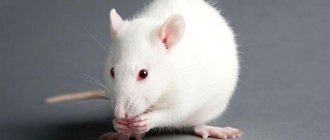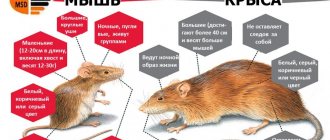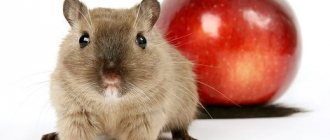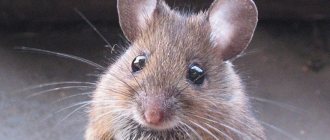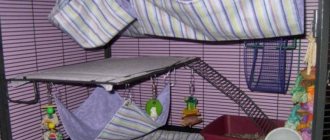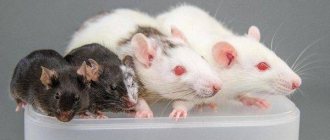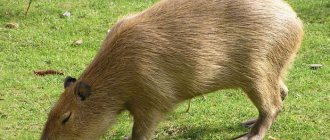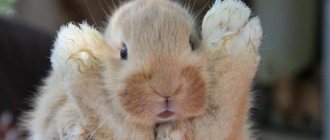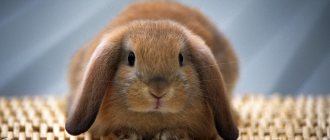Almost every person has acquired a pet at least once in their life. Some prefer common types of pets such as cats and dogs. Some people like exotic reptile species. Well, some owners keep a white mouse as a pet.
has been considered a pet for many years . The origin of these cute animals is controversial. Some sources indicate that the decorative mouse existed before our era. But a more common description of the origin of these mice points to the breeding of ornamental rodent species in laboratories for experiments.
Previously, in many countries there was a belief that if there is a white mouse in the house, it will protect the house from other rodents that can leave the owners without food supplies in a short time. Our ancestors also associated these cute animals with joy. To this day, many people have a favorable attitude towards this decorative animal.
Character and size
in size to its brothers . Their weight is about 30 grams. The length of the body and tail is no more than 11 centimeters.
Absolutely all mice of this species are active. Despite their excessive activity, they are absolutely harmless both to their owners and to other decorative rodents in the house. To have several individuals of this species, the owner does not have to acquire several cells. Mice will live in harmony and agreement even in the same territory, provided that they were placed in a cage of the same age. When a newcomer moves in, the mice will show him with all their appearance that this is their territory and he is clearly a stranger here. Often such settlements end in tears for a new mouse. But this case may be the only act of aggression on the part of ornamental rodents.
In addition to its activity and kindness, the white mouse differs from its relatives in its strong parental love. In addition to the female, the male also takes care of the newborn mouse. This phenomenon is rarely seen among animals.
How to breed decorative mice
Pregnancy in a female lasts no more than 21 days. One litter can have up to 7 mice, weighing about 1.5 grams. Like many newborn animals, children of the decorative rodent are born not only blind and deaf, but also completely bald. After a few days of age, little mice develop a small fluff on their backs. After a week after birth, their bodies are completely covered with hair.
The female feeds the offspring for 4 weeks. But, despite this, already two hours after the female has given birth, she is ready for another fertilization.
Upon reaching the age of one month , decorative mice can take care of themselves without the intervention of their parents. Three months after birth, rodents are able to have offspring themselves.
The average lifespan of rodents is 2-3 years. There have been cases where a white mouse has crossed the threshold at 5 years.
What to feed white mice at home
White mice are unpretentious in food. Despite this, it is very important to maintain a balanced diet, as with any animal.
White ferret - description of the species, size and character
A rodent's diet may include:
- grain crops (oats, millet, barley, millet, corn);
- pumpkin, sunflower, flax, hemp seeds;
- vegetables (cabbage, root vegetables);
- fruits (apples, pears);
- green plants (leaves and stems);
- cottage cheese;
- boiled milk;
- animal food: mealworms or other invertebrates, some boiled meat;
- special granulated food for mice. Particular attention should be paid to the composition of the product. It should not contain harmful chemical dyes.
It is important to periodically add vitamin and mineral complexes to the diet to maintain and improve the animal’s health. This is especially useful and necessary for pregnant and lactating individuals.
Important! Salty, fatty, spicy, smoked and fried foods, as well as confectionery sweets, are strictly contraindicated for pets.
White mice should be fed no more than once a day. The norm is 1 teaspoon per individual. The mice are given unboiled tap or well water, but most importantly, clean water.
Content
In terms of keeping the mouse, it does not require thorough attention and the selection of special food. Plus, the cost of maintaining these pets is quite low .
This decorative rodent from the white mouse family is very easy to train. Once the mouse gets used to its owner, it will not hesitate to come to its owner's arms. When letting a mouse go for a walk from its cage, it is better to keep an eye on it with both eyes. Because if she hides somewhere, then finding her will be a difficult task.
Varieties
House mice have a huge number of species. The most famous include:
- Little ones. Such rodents are the smallest mammals in Europe. They are red or brown. The abdomen of these pets is white or gray. The animals grow up to 13 cm in length. They are distinguished from other breeds by the shortened shape of their muzzle.
- Gerbils. Externally, this species resembles chipmunks. They are characterized by a short tail and a relatively large body when compared with other similar rodents.
- Needle mice. Pets of this breed may remind you of hedgehogs. The shape of their fur is like needles. It is this feature that greatly distinguishes these animals from other types of rodents. In addition, they are distinguished from other pets by the appearance of their eyes. They are black in color and have a round convex shape.
House for a decorative mouse
Although these pets are not particularly picky in terms of their maintenance , it is worth knowing some mandatory things regarding housing :
- The cage must be made of metal. The presence of a retractable tray will simplify the process of cleaning the cage and feeding the pet. But when choosing a cage, you should pay attention to the gap between the pallet and the holes. It should be at least 10 centimeters, since if the distance is greater, the mouse will be able to easily crawl into it and its search around the apartment will take a lot of time.
- Requires daily change of litter.
- The cage should be located away from heating devices and drafts.
Some owners believe that an ornamental pet can be placed in an aquarium. This idea is not the best, since glass walls tend to fog up quickly. And cleaning such a home will take much longer than a cage. Even if the owner decides to place his pet in such housing, he should purchase a metal mesh with small holes . This will allow the pet to breathe deeply and protect the owner from escaping his little friend.
What must be present in the cell?
- Small pieces of chalk. If there is a shortage of chalk, then you can place parts from branches in the cage. A rusty piece of bread also works well. These things are necessary for the rodent to sharpen its teeth and to prevent further growth of the incisors and add the necessary minerals to the diet for the healthy growth of the mouse.
- Litter. The most common bedding materials for rodents are paper and sawdust. A good alternative to these materials is hay.
- Wheel. This is perhaps one of the important attributes for the health of a rodent. Due to their activity, mice will not be able to sit still. And it is the running wheel that will remove all the accumulated energy from it.
Habitats and lifestyle in nature
Mice live on all continents of the globe, except Antarctica. As a rule, they live in deciduous and coniferous forests, steppe zones, mountains, tropical thickets and swampy areas. They also settle in people's houses.
These rodents make nests for themselves. For this they use dry grass stems. The above mammals are capable of creating a complex system of underground passages in order to live in it. They often occupy existing burrows. Species of these animals that live in swamps can swim, unlike those that live in other areas.
Also learn how to tell a mouse from a rat.
In Russia, mice are common. They do not live only in the northern part of Siberia, in the mountain tundras, on Taimyr and near the Lena and Yenisei rivers.
White mouse food
In order for the pet to be healthy , the owner should remember that the diet must be balanced. The daily consumption rate is 50 grams of food feed. You can use it as food:
- Cereals.
- Vegetables.
- Curd products.
- Grass is a complete source of minerals necessary for the normal functioning of the rodent’s body.
- If the owner decides to use the seeds as feed, then it should be remembered that they must be raw.
- Fertilized and lactating females need fish oil.
- It is advisable to give your pet some raw meat once a week.
- Under no circumstances should mice be fed sweet, salty or fatty foods.
The dosage of food should be optimal . Although rodents live in peace and harmony and are ready to share food with each other, they should not be limited in food. Also, excessive consumption of food will not benefit them.
To summarize, we can say that these peaceful and active animals do not require excessive care when living as a pet. Periodic change of bedding, arrangement of the house and a balanced diet is all that is needed for the healthy growth of a decorative mouse. If you do not neglect these rules, then a happy animal will, without a doubt, thank its owner with love and curiosity, and will become a best friend who will not only be a pet, but also part of the family.
White mouse: appearance of the species
The white mouse is a direct descendant of common house mice. As a species, it appeared about 3,500 thousand years ago. Now this is one of the most common types of rodents. They live everywhere except in permafrost regions and highlands.
The white mouse is a popular pet
For your information! Closest relatives are jerboas, hamsters, chinchillas
The white mouse was initially considered a noble and unusual animal due to its non-standard color. She was kept in houses and temples in China and Japan, as well as in Mediterranean countries. There, the image of a white mouse was sacred: it was not just bred for aesthetic pleasure, but was even worshiped. The adaptability and cleanliness of the animal, as well as the ability to be friendly towards representatives of its species, were noted.
Keeping animals began more than 1.5 centuries ago. ago, after their mass import to Europe for experimental research.
For more than a century, white mice have been used as experimental animals.
Mouse health
The health and life expectancy of a domestic mouse depends on the conditions of its maintenance and care. If you choose the right cage location and proper nutrition, the rodent will live a long and happy life. The owner also needs to monitor the behavior and condition of the mouse, responding to the following alarming symptoms:
- apathy and impaired motor activity;
- lack of appetite;
- untidiness of appearance – tousled fur, loss of tufts of fur;
- blood in the urine and discharge from the anus;
- teary eyes.
If you regularly pick up the mouse and examine it, health problems can be noticed in the early stages, therefore, it will be possible to seek professional help in time.
Prevention of mouse diseases is as follows:
- Proper nutrition.
- Compliance with containment conditions.
- Quarantine for new arrivals (for 1-2 weeks with constant monitoring) and sick individuals (the duration depends on the course of the disease).
Setting up a cage for mice
To make your mouse cozy and comfortable, you need to purchase a spacious cage, which can be made from both natural and synthetic materials. The best option would be a rectangular cage with metal bars and a wooden base. The height of the cage is at least 50 cm, and the floor dimensions are 40x40 cm.
This space is enough for one mouse seed to sit comfortably in the cage. To observe the life of your tailed pets, it is best to install transparent houses and tunnels in their home.
The cage must be equipped with a feeder and an automatic drinker. This will allow you to maintain a certain cleanliness in the mouse house, since your pets will knock over food and spill water. It is best to fill the bottom of the cage with fresh sawdust.
If there is only one pet in the cage, then the smell from it will be almost invisible. But when keeping a mouse family, it is best to use a false bottom in the cage. In this case, through small holes on the floor in the cage, feces will be poured onto a special tray, which will allow you not to bother yourself with daily cleaning.
Rat as a pet: advantages
Many people prefer pet rats as this is an ideal option. Despite the fact that for many people the mere mention of rats causes an ambiguous reaction, when they pick up this cute creature they instantly change their attitude. This is not at all surprising, since decorative and domestic rats are two very different things. As a result of training, these animals are able to master various tricks that make both children and adults admire them.
Caring for a pet is quite simple, since it requires a spacious cage, litter, water and cheap food. If you think of a domestic rat as a dirty and infectious rodent, then this is a huge mistake, since the decorative rodent is considered a very clean animal. If you clean the animal’s cage in a timely manner, then there can be no talk of any smell. The rat itself chooses one of the corners to relieve itself. If for some reason a bowl of food ends up near this place, then the rat drags it with its teeth to a clean place, away from this corner.
This rodent's need for communication is quite high. It is necessary to take into account the fact that each animal, as a separate person, with its own needs and with its own character
It is very important to understand this in time. The domestic rat quickly remembers voices and smells, responding to its name
If you have training skills, you can train your rat to fetch small objects.
This cheerful living creature often plays for hours with children and adults, which lifts the spirits of all family members, forgetting about pressing problems. They feel great in human hands and squeak with pleasure when their belly, back and ears are stroked. These are animals that easily relieve the stress of any person who feels some kind of oppression from work or other everyday worries. Keeping such animals at home gives a person extremely positive emotions, the level of which determines a person’s psycho-emotional state.
Decorative Rat - All about the type of rodent | Type of rodent – Decorative Rat
Watch this video on YouTube
Dental system
Rodents have well-developed incisors: two pairs on each jaw. The front teeth have no roots and grow throughout the mouse's short life. To prevent excessive growth, mice must constantly grind them down. The upper incisors are much larger than the lower ones, and are covered with durable enamel on the front.
Pests do not have fangs; instead, the jaw has a toothless edge - a diastema, behind which there is a palisade of molars. With their help, food is ground and crushed. The surface of some teeth is smooth, while others are covered with tubercles. Like incisors, molars are constantly growing and need to be ground down. Tree branches are perfect for these purposes.
When trying to gnaw on something metal or hard, the lower incisors may break, which leads to an incorrect bite: the teeth of the upper jaw bend inward, the animal is unable to close its mouth, cannot eat, and as a result dies from starvation.
Pros and cons of keeping mice
A person who wants to become the owner of a decorative mouse needs to clearly understand all the advantages and disadvantages of this solution. You should not get a rodent if you have family members with allergies or a panic fear of such creatures. Mice are also not suitable as pets for small children and people who keep a large number of other pets.
Among the advantages of keeping these particular animals:
- The small size of the animals means that the established place of residence will not occupy a significant area. For decorative mice, a cage is sufficient in which each individual receives approximately 15-25 cm of space (but the more, the better).
- Relatively cheap . Store-bought food for pet mice is inexpensive, and each individual needs only 10-12 g of food daily.
- Purity . With regular maintenance, your home will not smell like mice. In addition, they rarely leave odorous “nuisances” in the corners, compared to cats or dogs.
- Training opportunity . With desire and effort, mice can be taught some tricks.
- Aesthetic appearance . Decorative animals look very attractive, and the owner can choose any pet for himself - bald, shaggy, snow-white or chocolate.
Disadvantages of choosing domestic mice as a pet:
- Mice don't like to play with their owner too much . Rodents view humans solely as a source of food.
- The lifespan of pets is a maximum of 3-4 years (with the best care and treatment - 5 years). In addition, it is quite difficult for mice to provide medical care, which also does not contribute to long life.
- Animals require care . If the owner wants the decorative rodent to live a long time, and the house not to smell of “mouse presence,” he will have to regularly clean the cage, wash the house and toys, and also create the right diet.
- Night activity mode . Running around the cage, using the wheel, crunching near the feeder - the owner will hear all these sounds just when he is getting ready to go to bed.
- A threat to things and the pet itself . If a mouse is given freedom of movement in a human home, it can chew furniture, and in cases where wires and sockets are in the access area, cause serious harm to itself.
The fact that decorative mice are quite indifferent to the owner is both a minus and a plus. On the one hand, you won’t be able to play with such a pet. On the other hand, these are ideal pets for those people who have little free time.
